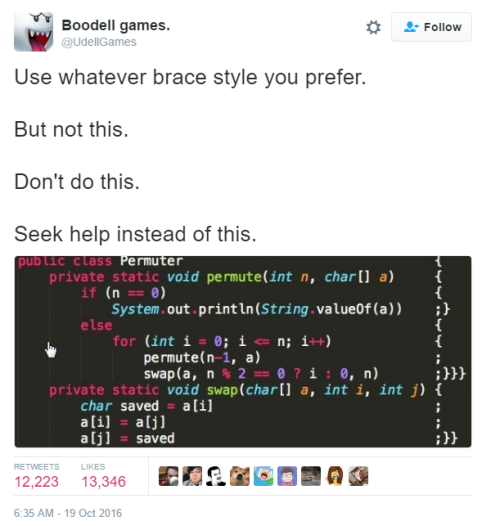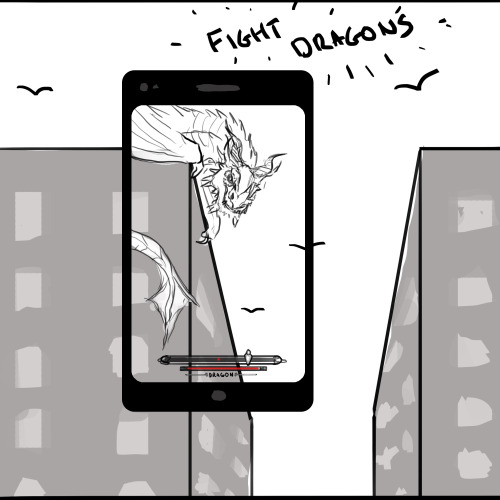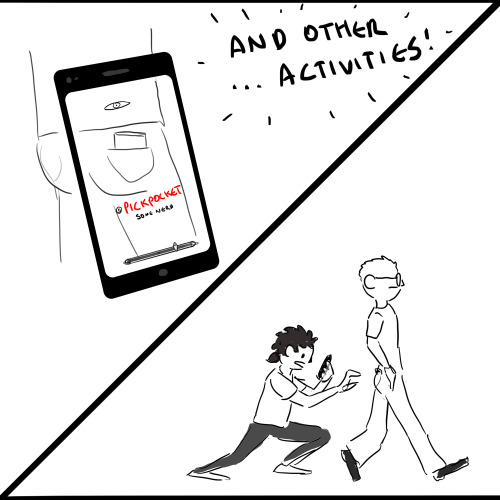I Think It's Java? Just Really, Really Bad Java
I think it's Java? Just really, really bad Java

More Posts from Stubborn-turtle-blog and Others

Computer Room Not Found

Phone becomes your weapon if spells aren’t equipped





no cheese shop would be safe









Casa Sperimentale’ Ruins
Architect: Giuseppe Perugini
Location/Year: Via Porto Azzurro, 57, 00054 Fregane RM (Rome) Italie / 1971
Pictures/Source: Oliver Astrologo + Google / designboom
The Gasoline Station is a proud partner of the Minuscule community network.
Artists + Bloggers + Sponsors = Stronger Together
50, 100 years down the line, will this be in the history books? Will the "War on terror" be over?

Battle of Mosul begins as forces push toward Islamic State stronghold.
Vote down ballot - the presidency isn't the only office of importance!
Time for another political essay. If you’re not an American citizen or able to vote in this upcoming election, my apologies.
I make no secret that I fucking despise Donald Trump. I actually like Hillary Clinton, which seems to be a weird rarity considering the amount of good work she’s done and the fact that all of the bad press about her is the result of the Republicans trying (and failing) to tear her and her husband down for thirty years.
Trump is now trailing far behind Clinton, which I consider a cause for celebration. But it is NOT a cause for complacency.
The biggest landslide election in US history was the election of Warren G. Harding in 1920, when Harding won with about 60% of the vote to his opponent’s 34.2%.
Some polls are reporting Trump with as little as 35% of the popular vote right now.
If turnout is large enough and loud enough, we can make Donald Trump the least supported major candidate in US history. Since the recording of him bragging about sexual assault came out, he has turned to dragging the whole election into the mud by striking back at Bill Clinton’s affairs; the usual goal of that kind of tactic is to drive down voter turnout. Trump’s band of Redcaps is pretty much guaranteed to vote, so they figure if they reduce turnout enough, they’ll win.
I want their plan to fail. I want their plan to fail so fucking spectacularly that NO ONE will dare to run for President on a platform of thinly-veiled fascism again.
The Republicans thought the House of Representatives was safe this year. In 2010, they gerrymandered the shit out of district lines to keep the House safe for them for at least ten years. But there’s a problem with gerrymandering: if the demographics shift unexpectedly between censuses, then suddenly a lot of districts wind up flipping against the party that the gerrymandering was meant to support. And Donald Trump is driving away the Republicans’ most secure core of voters, the evangelicals. And as I’ve said before: Congress is MORE important than the presidency.
If turnout is strong enough, and if people vote down ballot, the possibility exists for a massive upset. A Democratic presidency, a Democratic House, a Democratic Senate. They’re within our grasp. All you need to do, voters, is show up.
Motherfuckers don’t want you to vote. Young people, people of color, women, LGBTQ+ folks–they want you to be scared away, or to be convinced that voting doesn’t matter. They want your voice silenced. Don’t give the fuckers the satisfaction of letting it happen.
GO VOTE. VOTE DOWN-BALLOT. MAKE TRUMP THE BIGGEST LOSER IN US HISTORY.
IF YOU CAN’T BE BOTHERED TO VOTE OUT OF CONVICTION, THEN DO IT OUT OF SPITE.
Massive shout-out to the one woman team
Sample Return Robot Challenge
It’s been a long, technical journey for the seven teams competing this week in Level 2 of our Sample Return Robot Challenge. Over the past five years, more than 50 teams have attempted the $1.5 million competition, which is looking to develop autonomous capabilities in robotics. Basically, we want robots that can think and act on their own, so they can travel to far off places – like Mars – and we can rely on them to work on their own when a time delay or unknown conditions could be factors.
This challenge has two levels, both requiring robots to navigate without human control and Earth-based tools (like GPS or magnetic compassing). The robot has to find samples, pick them up and deliver them to home base. Each of the final seven teams succeeded at Level 1, where they had to find one sample, during previous competition years. Now, they have a shot at the much more difficult Level 2, where they have a two-hour window to locate up to 10 samples of varying point values, but they don’t know where to look or what exactly they’re looking for.
Get to know the final seven, and be sure to cheer them on as we live-stream the competition all day Sept. 4 and 5.

West Virginia University Mountaineers Hailing from: Morgantown, West Virginia # of Team Members: 12
Behind the Name: In West Virginia, we call ourselves mountaineers. We like to explore unknown places and be inspired by nature.
Motivation: To challenge ourselves. Through this venture, we are also hoping to create research and career opportunities for everyone on the team.
Strategy: Keeping things simple. Through participating in SRR challenge during the last three years, we have gone a long way in streamlining our system.
Obstacles: One of the biggest challenges was finding and nurturing the talent of individual team members and coordinating the team in making real progress on time.
Prize Plans: We donated 50 percent of our 2015 Level 2 prize money to create an undergraduate “Robotics Achievement Fellowship” at WVU. The rest of the funding was allocated to support team member professional development, such as traveling to conferences. A similar model will be used if we win in 2016.
Extra Credit: We did an Easter egg hunt with our robot, Cataglyphis (named after a desert ant with extraordinary navigation capabilities), last year.

Survey Hailing from: Los Angeles, California # of Team Members: Jascha Little
Behind the Name: It’s short, simple, and what the robot spends a lot of its time doing.
Team History: We work together, and we all thought the challenge sounded like an excellent way to solve the problem of what to do with all our free time.
Motivation: We are all engineers and software developers that already work on robotics projects. Reading too much sci-fi when we were kids probably got us to this point.
Strategy: We are trying to solve the search-and-return problem primarily with computer vision. This is mostly to reduce cost. Our budget can’t handle high quality IMUs or LIDAR.
Prize Plans: Probably build more robots.
Extra Credit: Favorite pop culture robot is Bender (Futurama). Alcoholic robots are the best.

Alabama Astrobotics (The University of Alabama) Hailing from: Tuscaloosa, Alabama # of Team Members: 33
Behind the Name: “Alabama Astrobotics” was chosen to reflect our school affiliation and our mission to design robotics for various space applications.
Team History: Alabama Astrobotics has been involved with other NASA robotics competitions in the past. So, the team is accustomed to the competition environment.
Motivation: We are pleased to have advanced to Level 2 in our first year in the competition (the first team to do so), but we are also not satisfied with just advancing. Our goal is to try to solve Level 2.
Strategy: Our strategy is similar to that used in Level 1. Our Level 1 approach was chosen so that it would translate to Level 2 as well, thus requiring fewer customizations from Level 1 to Level 2.
Obstacles: As a university team, the biggest challenge was not having all our team members available to work on the robot during the time since Level 1 completed in June. Most of my team members have either graduated or have summer internships, which took them away from campus after Level 1. Thus, we didn’t have the manpower to address the additional Level 2 technical challenges.
Prize Plans: Any prize money would be donated to the University of Alabama College of Engineering.
Extra Credit: Alabama Astrobotics also competes in the annual NASA Robotic Mining Competition held at the Kennedy Space Center each May. We have been fortunate enough to win that competition three times in its seven year history, and we are the only team to win it more than once.

MAXed-Out Hailing From: Santa Clara, California # of Team Members: 4
Behind the Name: Several reasons: Team leader is Greg Maxwell, and his school nick name was Max. Our robot’s name is Max, which is one of the most common name for a dog, and it is a retriever. Our efforts on this has been too the max…. i.e. MAXed-Out. Our technology requirements have been pushed to their limits - Maxed-Out.
Team History: Greg Maxwell started a Meet-up “Silicon-Valley Robot Operating System” SV-ROS that was to help teach hobbyists how to use ROS on their robots. We needed a project to help implement and make real what we were teaching. This is the third contest we have participated in.
Motivation: There is still such a long way to go to make robots practical. Every little bit we can contribute makes them a little bit better and smarter. Strategy: Level 1 was a test, as a minimum viable product to prove the tech worked. For Level 2, we had to test and add obstacle avoidance to be able to cover the larger area with trees and slopes, plus add internal guidance to allow for Max to be out of the home base camera tracking system.
Obstacles: Lack of a cost effective robot platform that met all the requirements; we had to build our own. Also time and money. The two months (between Level 1 and 2) went really fast, and we had to abandon lots of cool ideas and focus on the basics.
Prize Plans: Not sure, but pay off the credit cards comes to mind. We might open-source the platform since it works pretty well. Or we will see if it works as expected. We may also take a break / vacation away from robots for a while.
Extra Credit: My nephew, Max Hieges, did our logo, based on the 1960-era Rat Fink sticker.

Mind & Iron Hailing From: Seattle, Washington # of Team Members: 5
Behind the Name: It was the original title for Isaac Asimov’s “I Robot,” and we thought it was a good combination of what a robot actually is – mechanical and brains.
Team History: Three of us were WPI undergrads and met at school; two of us did our master’s degrees at the University of Washington, where we met another member, and then another of us brought on a family member.
Motivation: We saw that there was an opportunity to compete in a challenge that seemed like there was a reasonable solution that we could tackle with a limited budget. We saw three years of competition and thought that we had some better ideas and a pretty good shot at it. Strategy: The samples and the terrain are much more complex in Level 2, and we have to be more careful about our navigation. We are using the same tools, just expanding their capability and scope.
Obstacles: The team being spread over three different time zones has been the biggest challenge. We are all doing this in our free time after work. The internet has been really handy to get things done.
Prize Plans: Probably invest in more robot stuff! And look for other cool projects we can work on, whether it’s another NASA challenge or other projects.
Extra Credit: We are hoping to collaborate with NASA on the professional side with surgical robots to exoskeletons. Challenge-related, our robot is mostly made of plywood – it is a composite fiber material that works well for fast development using cheap materials.

Sirius Hailing From: South Hadley, Massachusetts # of Team Members: 4
Team History: We are a family. Our kids are both robot builders who work for Boston Dynamics, and they have a lot of robot expertise. Both of our kids are robotics engineers, and my wife is intrinsically brilliant, so the combination of that makes for a good team.
Motivation: Because it’s a really hard challenge. It’s one thing to drive a robot with a remote control; it’s another to do the whole thing autonomously. If you make a single change in a robot, it could throw everything off. You have to think through every step for the robot. On a basic level, to learn more about robotics and to win the prize. Strategy: Very similar to Level 1. We approached Level 1 knowing Level 2 was there, so our strategy was no different.
Obstacles: It is very difficult to do object recognition under unpredictable conditions – sun, clouds, weather, sample location. The biggest challenge was trying to recognize known and unknown objects under such a wide variety of environmental possibilities. And the terrain is very different – you don’t know what you’re going to find out there.
Prize Plans: We haven’t really thought about it, but we will give some away, and we’ll invest the rest in our robotics company.
Extra Credit: The first robot we had was called Robo-Dad. Dan was training to be an astronaut in the 1990s, so we built a toy remote-controlled truck that Dan - in Texas - could control via the internet in the house. Robo-Dad had a camera that Dan could see the house with. It had two-way communication; it was a little before it’s time – the internet was very slow.

Team AL Hailing From: Ontario, Canada # of Team Members: 1
Team History: I was looking for competitions that were open, and my dad had followed the Centennial Challenges for a while, so he alerted me to this one. I was already doing rover projects, and it was appropriate and awesome and interesting. I felt like I could do it as a team of one.
Motivation: Difficult challenges. I’m definitely inspired seeing really cool robots that other people are building. New emerging tech really motives me to create new things.
Strategy: I showed up with another robot to Level 2. I built three, but ran with only two. It did make it more complicated, but the strategy was to send them to different areas and have them be able to communicate with each other. Everything physically was the same from Level 1. The idea is that they would all go out with different missions and I would maximize field coverage.
Obstacles: Time. More time would always be nice. Being able to make something like this happen under a timeline is really difficult. I feel like I accomplished a lot for a year. Also, manpower – being a team of 1, I have to do all of the paperwork and other related stuff, but also carry the hardware and do the programming. You have to multitask a lot.
Prize Plans: I’d like to start a robotics company, and be able to expand some of the things I’ve been working on associated with technology and maker education.
Extra Credit: My story is not linear. A lot of people are surprised to hear that my background is in molecular biology and research. I once lived in a tent in Madagascar for a few months to do a biodiversity study, and I have multiple publications from that side of my life. I am in a whole different place now.
The competition is one of many run by our Centennial Challenges program, which looks to the public – citizen inventors, academics, makers, artists, YOU – to help us advance technology and bring a different perspective to obstacles that gets us outside of our traditional solving community. See what else we’re working on here.
Make sure to follow us on Tumblr for your regular dose of space: http://nasa.tumblr.com
Using the Power of Space to Fight Cancer
From cancer research to DNA sequencing, the International Space Space is proving to be an ideal platform for medical research. But new techniques in fighting cancer are not confined to research on the space station. Increasingly, artificial intelligence is helping to “read” large datasets. And for the past 15 years, these big data techniques pioneered by our Jet Propulsion Laboratory have been revolutionizing biomedical research.
Microgravity Research on Space Station
On Earth, scientists have devised several laboratory methods to mimic normal cellular behavior, but none of them work exactly the way the body does. Beginning more than 40 years ago aboard Skylab and continuing today aboard the space station, we and our partners have conducted research in the microgravity of space. In this environment, in vitro cells arrange themselves into three-dimensional groupings, or aggregates. These aggregates more closely resemble what actually occurs in the human body. Cells in microgravity also tend to clump together more easily, and they experience reduced fluid shear stress – a type of turbulence that can affect their behavior. The development of 3D structure and enhanced cell differentiation seen in microgravity may help scientists study cell behavior and cancer development in models that behave more like tissues in the human body.

In addition, using the distinctive microgravity environment aboard the station, researchers are making further advancements in cancer therapy. The process of microencapsulation was investigated aboard the space station in an effort to improve the Earth-based technology. Microencapsulation is a technique that creates tiny, liquid-filled, biodegradable micro-balloons that can serve as delivery systems for various compounds, including specific combinations of concentrated anti-tumor drugs. For decades, scientists and clinicians have looked for the best ways to deliver these micro-balloons, or microcapsules, directly to specific treatment sites within a cancer patient, a process that has the potential to revolutionize cancer treatment.

A team of scientists at Johnson Space Center used the station as a tool to advance an Earth-based microencapsulation system, known as the Microencapsulation Electrostatic Processing System-II (MEPS-II), as a way to make more effective microcapsules. The team leveraged fluid behavior in microgravity to develop a new technique for making these microcapsules that would be more effective on Earth. In space, microgravity brought together two liquids incapable of mixing on Earth (80 percent water and 20 percent oil) in such a way that spontaneously caused liquid-filled microcapsules to form as spherical, tiny, liquid-filled bubbles surrounded by a thin, semipermeable, outer membrane. After studying these microcapsules on Earth, the team was able to develop a system to make more of the space-like microcapsules on Earth and are now performing activities leading to FDA approval for use in cancer treatment.

In addition, the ISS National Laboratory managed by the Center for the Advancement of Science in Space (CASIS) has also sponsored cancer-related investigations. An example of that is an investigation conducted by the commercial company Eli Lilly that seeks to crystallize a human membrane protein involved in several types of cancer together with a compound that could serve as a drug to treat those cancers.
“So many things change in 3-D, it’s mind-blowing – when you look at the function of the cell, how they present their proteins, how they activate genes, how they interact with other cells,” said Jeanne Becker, Ph.D., a cell biologist at Nano3D Biosciences in Houston and principal investigator for a study called Cellular Biotechnology Operations Support Systems: Evaluation of Ovarian Tumor Cell Growth and Gene Expression, also known as the CBOSS-1-Ovarian study. “The variable that you are most looking at here is gravity, and you can’t really take away gravity on Earth. You have to go where gravity is reduced."
Crunching Big Data Using Space Knowledge

Our Jet Propulsion Laboratory often deals with measurements from a variety of sensors – say, cameras and mass spectrometers that are on our spacecraft. Both can be used to study a star, planet or similar target object. But it takes special software to recognize that readings from very different instruments relate to one another.
There’s a similar problem in cancer research, where readings from different biomedical tests or instruments require correlation with one another. For that to happen, data have to be standardized, and algorithms must be “taught” to know what they’re looking for.
Because space exploration and cancer research share a similar challenge in that they both must analyze large datasets to find meaning, JPL and the National Cancer Institute renewed their research partnership to continue developing methods in data science that originated in space exploration and are now supporting new cancer discoveries.
JPL’s methods are leading to the development of a single, searchable network of cancer data that researcher can work into techniques for the early diagnosis of cancer or cancer risk. In the time they’ve worked together, the two organizations’ efforts have led to the discovery of six new Food and Drug Administration-approved cancer biomarkers. These agency-approved biomarkers have been used in more than 1 million patient diagnostic tests worldwide.
Make sure to follow us on Tumblr for your regular dose of space: http://nasa.tumblr.com






RoboAction
Painting series by Dragan Ilić features abstracted mark-making using an industrial robot, sometimes carrying and guiding the artist himself:
The artist constantly transposes into the third dimension his decade’s long-running conceptual practice based on the usage of pencils as the basic draftsman’s tool, starting primarily with the media of performance art, installation and sculpture in extended field. Gradually, over the years, his expressive and mechanical compositions have become even more advanced with the development of modules, diverse in shape and sizes, devices designed for the task of mounting and holding his drawing tools, which has led ultimately to the construction of an appropriate drawing machine. Construed for non-artistic purposes, these robots have been reshaped into special draftsmanship implements with which the author is capable of processing his ideas at far greater speed and with considerably greater precision. The metamorphosis of the artistic work is positioned at a point where human and machine activity intersects, resulting in an interaction that is essentially based on the need to transcend the limitations of the human body.
More Here
learning to lead
you think you’re gonna be like

but really it’s like

hey man at least I can keep my feet while I’m turning a girl o-kay
-
 http-501 liked this · 1 year ago
http-501 liked this · 1 year ago -
 shadowedseas reblogged this · 2 years ago
shadowedseas reblogged this · 2 years ago -
 wakayume liked this · 3 years ago
wakayume liked this · 3 years ago -
 nosugaronmycoffee liked this · 3 years ago
nosugaronmycoffee liked this · 3 years ago -
 lostinsidemyminds liked this · 4 years ago
lostinsidemyminds liked this · 4 years ago -
 zyrkon01 liked this · 4 years ago
zyrkon01 liked this · 4 years ago -
 marxsposting reblogged this · 4 years ago
marxsposting reblogged this · 4 years ago -
 marxsposting liked this · 4 years ago
marxsposting liked this · 4 years ago -
 captaingraftin reblogged this · 4 years ago
captaingraftin reblogged this · 4 years ago -
 captaingraftin liked this · 4 years ago
captaingraftin liked this · 4 years ago -
 s00nstuck023 reblogged this · 4 years ago
s00nstuck023 reblogged this · 4 years ago -
 thekamiiiworld liked this · 4 years ago
thekamiiiworld liked this · 4 years ago -
 ilovebigmommymilkers liked this · 4 years ago
ilovebigmommymilkers liked this · 4 years ago -
 meestervan reblogged this · 4 years ago
meestervan reblogged this · 4 years ago -
 thousandevilducks liked this · 4 years ago
thousandevilducks liked this · 4 years ago -
 star-crossed-maniac-lunatic liked this · 4 years ago
star-crossed-maniac-lunatic liked this · 4 years ago -
 intricasize reblogged this · 5 years ago
intricasize reblogged this · 5 years ago -
 intricasize liked this · 5 years ago
intricasize liked this · 5 years ago -
 xxxpurp1exxx liked this · 5 years ago
xxxpurp1exxx liked this · 5 years ago -
 sqquares-fan-stuff reblogged this · 5 years ago
sqquares-fan-stuff reblogged this · 5 years ago -
 comfortable-scarecrow liked this · 5 years ago
comfortable-scarecrow liked this · 5 years ago -
 ijustthinkcheesecakeisneat liked this · 5 years ago
ijustthinkcheesecakeisneat liked this · 5 years ago -
 schlayeratheart liked this · 5 years ago
schlayeratheart liked this · 5 years ago -
 thedoubl3j reblogged this · 5 years ago
thedoubl3j reblogged this · 5 years ago -
 laaapower99 reblogged this · 5 years ago
laaapower99 reblogged this · 5 years ago -
 wackydoodle21 liked this · 5 years ago
wackydoodle21 liked this · 5 years ago -
 erikcaineolson liked this · 5 years ago
erikcaineolson liked this · 5 years ago -
 ar2456 liked this · 5 years ago
ar2456 liked this · 5 years ago -
 gloxinian reblogged this · 5 years ago
gloxinian reblogged this · 5 years ago -
 violet-amet reblogged this · 6 years ago
violet-amet reblogged this · 6 years ago
Gaming, Science, History, Feminism, and all other manners of geekery. Also a lot of dance
243 posts